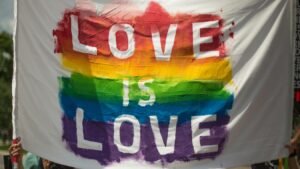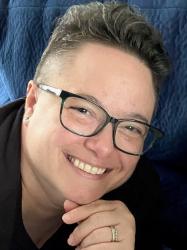This column was first published by Pickles & Ice Cream, which can also be found on Instagram, X, and Facebook.
Lynae Sowinski:
I came out as queer/bisexual/pansexual in my early 20s. I realized that I should actually start listening to those “girl crushes” I’d been noticing all my life. A few years later I met Josie, and we quickly became inseparable. We first started talking about becoming parents in one of those “30 questions to get closer to your significant other” lists — I replied I’d always wanted to be a parent; Josie was a bit more hesitant. Eventually, we became engaged, moved to Athens, and married. By then, we knew our family would include children.
Josie Leimbach:
I first came out as a lesbian as a teenager in the ’90s. At that time, the question of marriage equality was not even a consideration. I didn’t have a lot of examples of queer couples, and even fewer queer parents, which meant that I didn’t grow up having a strong desire to get married or have children. For the first three decades of my life, I was content to be in long-term relationships outside of marriage and staunchly child-free. That changed very quickly after meeting Lynae and realizing what we could build together as a couple and a family. While I wouldn’t say that this path is for everyone, I am glad that I experienced both sides of this perspective. Prior to my time with Lynae, I was not in a place — mentally, financially, or emotionally — that would have allowed me to do the work necessary to be a good parent and a healthy human. This is why I strongly advocate for people to have the ability to choose to parent, or not, at their own pace.

“While most of the people I encountered were supportive of my same-sex relationship, I’ve lost count of the number of times I had to correct people that I have a wife, not a husband.” —Lynae | Photo by Mikhail Nilov
Our preparation
While preparing for having a kid is similar to heterosexual couples in many ways, there are a variety of ways being a queer couple has made it different, and in some cases, harder (emotionally, physically, and financially). We also feel it necessary to acknowledge that we are incredibly privileged — as we are white, cisgender (we identify with the gender we were assigned to at birth), relatively financially resourced, and we have a strong support system.
Lynae:
One of the first questions we had to ask ourselves was who was going to carry the baby — we have two uteruses to choose from! This ended up being an easy decision for us. I’d always wanted to experience what my body was built to do, while Josie didn’t have that desire.
We then had to decide how we wanted to gain access to our missing ingredient (sperm) and how we would conceive. One common aspect of becoming a queer parent is to use the information from those who came before you to help make your decisions — friends, acquaintances, books, podcasts (shout out to The Queer Family Podcast). I scoured it all.
Some people choose to go with a known donor. This is when you ask someone you know to donate directly to you, often bypassing sperm banks and doctors. While a great option for many people, we decided it sounded too complicated for us. We chose to go to a sperm bank and use an open anonymous donor, meaning the donor would remain anonymous until our child is 18 years old when they’d be open to meeting. Everything we’ve read and heard suggests that the child having access to their donor and the donor’s medical information is extremely important.
There are a few different ways for two people with uteruses to get pregnant. Josie and I chose intrauterine insemination (IUI), where sperm is directly inserted into the uterus, generally by a doctor or midwife. Because we were going through a sperm bank, the sperm would be frozen and shipped. We liked that there was a professional involved so there was a lot less margin of error in the thawing and insemination itself. Many people choose to insert the sperm into the vaginal canal at home using a syringe. This is very common for folks using a known donor because you can use fresh sperm. Another common way for people to get pregnant is through in vitro fertilization (IVF), which is an invasive process that involves stimulating multiple eggs, retrieving them, fertilizing them outside of the body, and then implanting them into the uterus. This felt like too much for me and also could cost tens of thousands of dollars, which was prohibitive even if we wanted it.
Josie:

“There’s a kind of privilege to not be the subject of all of these procedures, but there’s also a challenge to have someone so important to me doing all this emotional and physical labor to meet our goal as a couple.” —Josie | Photo by Alexander Grey
Money was definitely a big factor in this process. Just to get started with sperm was a major investment and the costs continue to rise. This doesn’t account for the cost of transportation of the sperm and paying for the doctor’s services — and that was before we needed to navigate prenatal care, baby supplies, and more. Even though we were doing well financially and chose a less invasive and cheaper option, it was still a challenge. It’s hard not to compare this experience to folks in relationships who can find someone, fall in love, and have a baby without getting doctors, sperm donors, or sperm banks involved.
As the non-birthing parent, I was very invested in choosing the sperm donor. My first consideration was someone who looked like me — ideally with my hair color, skin tone, and a facial feature or two that I thought could mimic my own. It turns out that looking at sperm donors feels a lot like online dating. Each person was separated into different categories based on their characteristics, but they weren’t always in the ideal combination. We started by looking at a lot of factors. Did the donor’s ethnicity matter? Was a cleft chin more important than their eye color? Would we rather his eyes or his smile look like mine? And I remember Lynae distinctly mentioning looking for someone we would like if we were to meet them in person.
I honestly thought that choosing the donor would be an easier process — that there would be unlimited options and the perfect donor would appear. Turns out, for us at least, someone who met all of our goals didn’t exist. We had to simplify our criteria and focus on the qualities that mattered the most to us. For us, it was important to be flexible and stay focused on the bigger vision. We are really happy with the donor we chose.
“
It turns out that looking at sperm donors feels a lot like online dating. Each person was separated into different categories based on their characteristics, but they weren’t always in the ideal combination.
—Josie
”
Insemination
Lynae:
We knew going in that Josie would be separated from the conception in a way that many others aren’t, and we had to find a way to be okay with that. We also knew that Josie was going to be even more separated due to the fact that we were doing all of this during the height of the COVID-19 pandemic (I was stubborn with our timeline…). What I wasn’t prepared for was how medicalized the entire process felt.

“Everything we’ve read and heard suggests that the child having access to their donor and the donor’s medical information is extremely important.” —Lynae | Photo by Danny Castrejon
The simple fact that we didn’t have access to sperm automatically threw me into a world of infertility when there were no actual infertility needs. I had doctors’ appointments, bloodwork, and ultrasounds to prove my body was prepared for conception. In some ways, it’s kind of cool. I know so much more about my fertility, menstrual cycle, body, and conception than a lot of people do. In other ways, it’s caused a sterile distance with my body that I still haven’t quite figured out how to reconcile.
Josie:
There’s a kind of privilege to not be the subject of all of these procedures, but there’s also a challenge to have someone so important to me doing all this emotional and physical labor to meet our goal as a couple. At the same time, I couldn’t know what she was going through and sometimes felt like I didn’t know how to support her, in this process. While I’m so grateful I could be in the room for the insemination, the harsh lights of the doctor’s office, the mask requirements, and the presence of two other people all impacted my sensory perception of this experience. We worked hard to connect over this experience and recognize that it wasn’t going to look like the intimacy we’re taught to imagine around insemination.
Being pregnant
Lynae:
After the medicalized experience of getting pregnant, I really enjoyed how “normal” it felt to be pregnant. Finally, my doctor visits were just like everyone else’s. My body was doing what everyone else’s was. I could relate to most other mothers out there. But I was still stuck in a frustratingly heteronormative space, meaning a space that expected only heterosexual couples and wasn’t built to recognize that families could come in different forms. While most of the people I encountered were supportive of my same-sex relationship, I’ve lost count of the number of times I had to correct people that I have a wife, not a husband. I’ve also lost count of how many times I haven’t been in the headspace to correct them.
Josie:

“This was a learning experience about what it looks like to forge new paths that those outside your friends, family, and community may not understand.” —Josie | Photo by Alexander Grey
Part of the joy and sometimes frustration of queer parenting is figuring out what works for you. I experienced this, especially in relation to figuring out what I wanted our child to call me. For a while, we considered Mama and Mom, but as we grew closer to the due date, I realized more and more that I didn’t connect with the title “Mom.” There aren’t a lot of visible alternatives for parental names, so queer parents often create something that makes sense to us. Since I thought of myself as a parent more than a mom, I wanted to play on that more gender-neutral term. Eventually, we came up with the term Ren, as in paRENt. I love this term and our child has developed a riff on this to make it their own, which is amazing.
And of the many things I didn’t account for — Ren uses sounds that come later in speech development than Mama. I did expect there to be some confusion about the term itself, but I didn’t think about how this had the potential to further obscure the connection with my child. I’m so happy to be our child’s Ren, and this was a learning experience about what it looks like to forge new paths that those outside your friends, family, and community may not understand.
Parenthood
Lynae:
One rude awakening of parenthood for me is just how much this world is not built for our family. The number of times I have to cross out “father” while filling out paperwork is staggering. This includes Josie being listed as “father” on our child’s birth certificate. I never expected to have to advocate for my family as much as I’ve had to do.
Of course, we have all of the same parenting wins and struggles as everyone else, but there is often just an extra layer of exhaustion when it comes to having to advocate for and explain your family so frequently. Now that we have a child, we are even more aware of safety and making sure she is not exposed to negativity. We also want to make sure that our child knows the joy of being a queer family. She’s so lucky to have a Mama and a Ren. She is adored by her biological and chosen family. Plus, there are rainbows and parades celebrating her family.
“
I never expected to have to advocate for my family as much as I’ve had to do.
—Lynae
”
Josie:
Growing up I learned a very specific definition of family deeply tied to shared genetics. However, as I grew older, my understanding of family changed dramatically to better reflect my lived experience. When my parents divorced and remarried spouses with children, who I claimed as a family changed. When I became an adult and learned about the joy and comfort of finding family through my queer community, I shifted away from the idea of “blood relation” to focus more on those we actively choose to support and be supported by as well as the bonds of shared experience and understanding. Those experiences provided a powerful foundation for me to interpret my relationship with our child. Showing up, sharing experiences, supporting her, and putting in the time, all contribute to the bond we have.
The way that my bond with our child grew was different from Lynae’s. It was built over long nights, diaper changes, singing lullabies, and reading books, to name a few. Unfortunately, this connection doesn’t always translate to people who see us in public. Lynae and our child share an uncannily similar appearance. So much so, that it is a regular occurrence for friends, family, and strangers to remark on how much they look alike, and I sometimes feel left out of that physical manifestation of their connection. However, that’s less significant than those who ask whose child they are — meaning who gave birth and that the act of giving birth means that our child has a deeper connection and legitimacy with Lynae.
Another reminder of my non-birth parent status is the need to adopt my own child to legally protect our relationship. This process, called “step-parent adoption” in Georgia, provides legal recognition and ensures that my role as their parent is legally recognized. The experience of being required to go through this process still carries a tremendous emotional (and financial) toll. I have no desire to undermine the relationship between step-parents and their children. Yet I’m also frustrated by the specificity of our experiences being treated as the same thing rather than distinct from one another. There are many similarities to our experiences, but they are not the same.
Ongoing questions

“Our family is valid and built on love, and we have nothing we need to prove.” —Lynae and Josie | Photo by 42 North
We have some ongoing questions, especially now that our child is getting older.
She’s starting to recognize that her family looks different from her friends’ families. Will she feel deprived of a dad? What do we do when someone is inevitably mean to her about having two moms?
She doesn’t currently have a lot of representation of families with two moms (or two dads for that matter) and we’re actively trying to find more queer parents to help that.
Within the next few years, she’s going to start asking about her donor. We plan to be very open about the entire process, but this information includes potential donor siblings. We will need to make some serious decisions about how donor siblings (and their families) fit into our lives.
And we need to remind ourselves that we are human and sometimes flawed. We don’t have to be the perfect queer parents and we can mess up just like any other parent. What’s important is to keep showing up, learning, and trying to do better than we did yesterday. Our family is valid and built on love, and we have nothing we need to prove.



